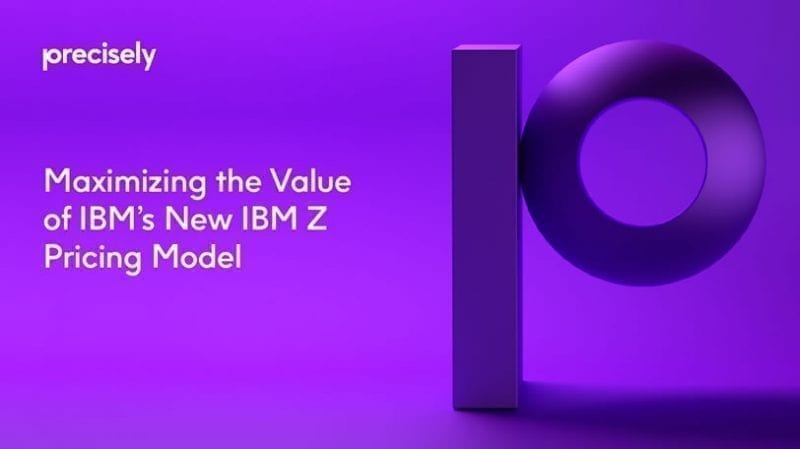eBook
Maximizing the Value of IBM’s New IBM Z Pricing Model
Read this eBook to learn how this new pricing model allows customers to realize even more savings with Precisely – through direct cost savings as well as delayed upgrades because of CPU usage reduction.
Introduction
IBM recently announced a new pricing model for IBM Z software charges for their mainframe customers. Tailored Fit Pricing is a new, flexible software pricing model that promises to simplify the existing pricing landscape. Two new pricing solutions, Enterprise Consumption and Enterprise Capacity, offer alternatives to the rolling four-hour average (R4HA) based pricing model, for both new and existing workloads.
The motivation behind the new pricing model had a lot to do with the challenges around the R4HA pricing model that has been in place since 1999. This model is what we’re all used to and how we’ve come to know the IBM software pricing. In the era of hybrid cloud, where everything is connected and workload patterns are constantly changing, predicting demand for IT services can be a major challenge. The new pricing model is intended to be a simpler, more transparent and predictable option for mainframe customers. IBM expects that these new tailored pricing models are going to be more attractive for many of their mainframe customers.


4HRA pain points
The 4HRA pricing model had a couple of challenges that we are all familiar with. The complexity around trying to manage it, measure it and accurately report it to IBM are all challenging for many organizations. Additionally, efforts to keep workloads running at certain times of day to minimize your cost on the 4HRA leads to additional effort and stress on the part of customers trying to architect their systems and their environments around the pricing model as opposed to architecting them for the best performance or the most optimal sort of deployment options. Further, the impact of short-term spikes in workloads could have an inordinate, and likely unpredictable, impact on a customer’s software licensing costs.
This encourages customers to spend way too much time on licensing cost considerations and staff resources devoted to figuring out how to best manage workloads to minimize 4HRA costs. The overall complexity of monitoring and managing the billing under 4HRA was one of the primary motivations for the new pricing. When IBM started to look at how they could do this better and make it easier for customers, it led to working very closely with their customers to design it in a way that would be positively received.
IBM tailored fit pricing overview
The overall objective of this new pricing model is to simplify the billing process for customers and make it more predictable and easier to understand. The removal of the complex and the capping idea is to get away from the amount of cycles that people are spending on those types of activities. The other goal is to get people to structure their environments around the optimal computing capacity and not worry so much about architecting around this 4HRA at their beacon.
Under this new pricing model, there are two different options: consumption based and capacity based. The Enterprise Consumption Model is pay-as-you-go with the idea that the costs are directly tied to how much you are using your machine.
The Enterprise Capacity Model is simple and is based on the capacity of the machine. Essentially, you pay for the full capacity of the mainframe. Let’s take a closer look at each model.
Enterprise Consumption Model
The Enterprise Consumption Model has a baseline that is set by looking at the previous 12 months’ MSU usage and then dividing by 12 to establish your monthly software cost. It simplifies the pricing because you’re only paying for what you use. If you underutilize your expected consumption amount, those additional MSUs are rolled over and can be used in the future. IBM also offers an incentive for growth above that committed baseline – so you will pay less for that growth than you would otherwise. Once a baseline is set, the growth is offered at reduced rates and there’s no additional qualification for those new workloads.
With this new pricing model, customers will be free to have their workloads execute where and when it makes the most sense for the business instead of worrying about licensing cost considerations. We expect that this is going to lead to steeper spikes and lower valleys in workload usage which in the long run will make the consumption model extremely attractive to customers.
Many businesses, like retailers, can have dramatic spikes in their workloads. When they run seasonal promotions like Black Friday or President’s Day sales, they typically see much higher than normal workloads. Under the 4HRA pricing model, these spikes would be reflected in dramatically higher software licensing costs. With the Enterprise Consumption model, the impact of these seasonal effects is minimized. Since the monthly billing is based on your last 12 months consumption divided by 12, the impact of a few spikes is “flattened out”. In addition, if you use less than your projected usage in a month, you’re able to rollover any unused capacity.
Precisely benefits under the new pricing models
Our Precisely products, including Precisely MFX and Precisely ZPSaver, are designed to improve your performance and efficiency to control costs across your IBM mainframe environment. Precisely MFX is a sort, copy and join application that takes advantage of the latest IBM Z Systems architecture to reduce billable time of sort jobs – with a reduced elapsed time by up to 40%. Precisely ZPSaver works with Precisely MFX to further reduce the workload on your mainframe’s CPU by off-loading sort operations to zIIP engines. By reducing your CPU consumption, both of these products can provide powerful ROI under the new IBM pricing to save your business money and deliver ever-faster processing power.
Prior to the new pricing models, we needed to analyze customers’ workloads and their 4HRA billing details to determine if, and how much, Precisely products would save them. If we found that the impact of Precisely’s reduction in CPU consumption was not going to bring down the 4HRA level, then the impact of our products would not be as strong.
Under IBM’s new Enterprise Consumption Pricing Model, any reduction in CPU usage, whether through more efficient sorting or offloading sorting to zIIP engines, can have a positive impact on a customer’s software licensing costs. As a result, the combination of Precisely MFX and Precisely ZPSaver will certainly save our customers money. In addition to the direct cost savings, there is also the benefit from the savings involved with delaying upgrades because of the reduction in CPU usage.
Precisely MFX and Precisely ZPSaver benefits
- Cost reduction using IBM’s new Consumption Model
- Continue to offer a high-performance sort, copy and join utility designed to explore the advanced facilities of the z/OS operating systems and IBM Z, including zIIP engines
- Can significantly reduce CPU utilization for sort operations to control software costs and delay CPU upgrades
- Frees up general purpose MIPS for handling increased data volumes and new workloads
- Drive cost reduction strategies by delaying CPU upgrades and reducing software charges

